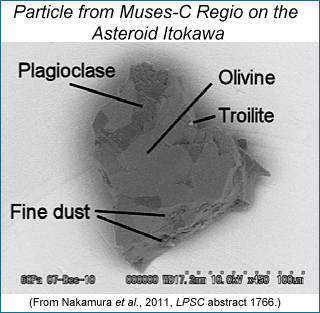Emily Lakdawalla • Sep 20, 2011
Reading Itokawa's life history from microscopic samples
Last month, the first results from the analysis of the grains of asteroid dust returned by Hayabusa from asteroid Itokawa were published in Science. When Hayabusa's sample return capsule was first opened and found to be very clean-looking inside, I doubted that there could be enough material for laboratory analysis. JAXA announced later that they scraped about 1500 dust grains from the inside with a teflon spatula, and these likely came from Itokawa. They were tiny, most of them smaller than 10 microns across. They later retrieved 40 larger grains ranging in size from 30 to 180 microns by turning the sample canister over, holding it over a silica glass plate, and -- I am not kidding -- tapping it with a screwdriver. Such a tiny amount of material -- how could they possibly do any good science with these few bits of dust?


The first paper provided a description of the mineral makeup of the grains, based on scanning electron microscopy and x-ray diffraction. They catalogued the 1534 grains from the Teflon spatula: 1087 were made up only of one type of mineral, while 447 were made of more than one. Of the single-mineral particles, most were the three very very common rock-forming minerals olivine (580), pyroxene (192), and feldspar (186). The rest were troilite, an iron sulfide (113), chromite, an iron chromium oxide (13), calcium phosphate (10), and iron-nickel metal grains (3). Of the multi-mineral particles, most were made of those common rock-forming minerals I mentioned earlier, but some were made of a mix of silicate minerals and potassium-bearing halite, which seems weird (halite, on Earth, is also known as salt).
Taken together, this catalogue makes the samples of Itokawa a perfect match to ordinary chondrite meteorites, so they confirmed that S-type asteroids like Itokawa are the origin of the most common type of asteroid that falls on Earth, ordinary chondrites. This conclusion was confirmed by other kinds of analyses reported in other Science papers, including oxygen isotope analysis, neutron activation analysis, The larger "tapped" particles are like miniature meteorites, made up of a variety of minerals that must have formed under a variety of conditions. With this mineralogical catalogue of the Itokawa particles, scientists were able to read the samples to tell the following story about Itokawa's history.
Once upon a time, an asteroid condensed from the solar system nebula. It condensed in a region of space where iron and the elements that like to be with iron had already condensed out, and grew to a size of more than 20 kilometers across. Like everything else in the solar system, some of its atoms were short-lived radioactive isotopes like aluminum-26. As these radioactive materials decayed, the interior of the asteroid heated up, reaching a peak temperature of about 800°C before beginning to cool again as the short-lived radioisotopes were depleted. The deep interior of the asteroid cooled slowly, at a rate of only about 1°C every 2000 years. This slow cooling annealed the asteroid's constituent grains -- atoms moved around and grains became interlocked.
Then there was a big impact that catastrophically broke up the asteroid, at every scale -- even its mineral grains were cracked from the shock of the impact. A small amount of its fragments -- a mixture of stuff from near its surface with stuff that had been in its deep interior -- coalesced into a rubble-pile asteroid. Over millions or billions of years, exposure to bombardment by micrometeorites and to energetic ions from the solar wind weathered the particles at the surface, causing nanometer-sized grains of iron to form in the ones that were exposed. The asteroid continued to be battered by impacts of various sizes, and the seismic shaking from these impacts made some grains rub against each other and tumble downhill into a local topographic low point, burying some. But most grains that were lofted off the surface by these impacts were lost completely, launched into space. In this way Itokawa is shrinking with time, losing tens of centimeters of material every million years. A little spacecraft launched from Earth, briefly touched down, and took away some dust particles and carried them back. In another few hundred million years, Itokawa will be gone.

The Time is Now.
As a Planetary Defender, you’re part of our mission to decrease the risk of Earth being hit by an asteroid or comet.
Donate Today

 Explore Worlds
Explore Worlds Find Life
Find Life Defend Earth
Defend Earth


